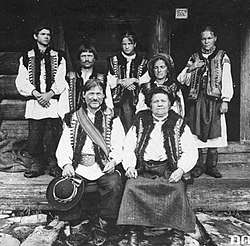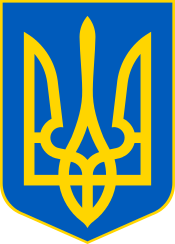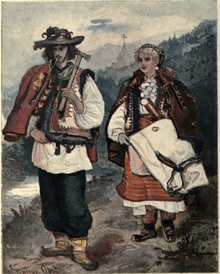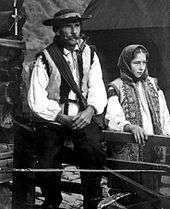Hutsuls
Hutsuls (Ukrainian: гуцули, hutsuly; Polish: Hucuł, plural Huculi, Hucułowie; Romanian: huțul, plural huțuli) is an ethnic group spanning parts of western Ukraine and Romania (i.e. parts of Bukovina and Maramureş). While they often have been officially designated as a subgroup of Ukrainians,[3] Hutsuls mostly regard themselves as a part of a broader Rusyn ethnicity, alongside two other groups from the cross-border region of Transcarpathia: the Boykos and Lemkos.[4][5][6]
 Hutsul family, 1925–1939 | |
| Total population | |
|---|---|
| 25,290 | |
| Regions with significant populations | |
| 21,400 (2001)[1] | |
| 3,890[2] | |
| Languages | |
| Ukrainian | |
| Religion | |
| Predominantly Ukrainian Greek Catholic or Orthodox, with Roman Catholic minorities | |
| Related ethnic groups | |
| Boykos, Lemkos, Rusyns | |
| Part of a series on |
| Ukrainians |
|---|
 |
| Diaspora |
|
see Template:Ukrainian diaspora |
| Sub-national groups |
| Boikos · Hutsuls · Lemkos · Poleszuks |
| Closely-related peoples |
|
East Slavs (parent group) Rusyns · Poleszuks · Kuban Cossacks Pannonian Rusyns |
| Culture |
|
Architecture · Art · Cinema · Cuisine Dance · Language · Literature · Music Sport · Theater |
| Religion |
|
Eastern Orthodox (Moscow Patriarchate Orthodox Church of Ukraine) Greek Catholicism Roman Catholicism Judaism (among ethnic Jews) |
| Languages and dialects |
|
Ukrainian Russian · Canadian Ukrainian · Rusyn · Pannonian Rusyn Balachka · Surzhyk · Lemko |
|
History · Rulers List of Ukrainians |
Etymology
The origin of the name Hutsul is uncertain.[7] The most common derivations are from the Romanian word for "outlaw" (cf. Rom. hoț–"thief", hoțul–"the thief"), and the Slavic kochul (Ukr. kochovyk–"nomad") which is a reference to the semi-nomadic shepherd lifestyle or the inhabitants who fled into the mountains after the Mongol invasion.[4][7] Other proposed derivations include from the Turkic tribe of the Utsians or Uzians, and even to the name of the Moravian Grand Duke Hetsyla, among others.[8] As the name is first attested in 1816, it is considered to be of recent origin and as an exonym, used by neighboring groups and not Hutsuls themselves, although some have embraced it.[4] The region inhabited by Hutsuls is named as Hutsulshchyna.[9][10] Their name is also found in the name of Hutsul Alps,[11] Hutsul Beskyd,[12] Hutsulshchyna National Park,[13] and National Museum of Hutsulshchyna and Pokuttya Folk Art.[14]
History and origins


Hutsuls inhabit areas situated between the south-east of those inhabited by the Boykos, down to the northern part of the Romanian segment of the Carpathians. Several hypotheses account for the origin of the Hutsuls, however, like all the Rusyns, they most probably have a diverse ethnogenetic origin. It is generally considered to be descendants of the White Croats, a Slavic tribe that inhabited the area,[4][7][15] also Tivertsi, and possibly Ulichs who had to leave their previous home near the Southern Bug river under pressure from the Pechenegs.[4][7][16] There is also considered a relation to Vlach shepherds who later immigrated from Transylvania,[15][17] because of which some scholars like Romanian historian Nicolae Iorga argued that "huțuli" or "huțani" are denationalized Vlachs / Romanians.[18][19]
Language
Hutsul is usually considered to be a dialect of Western Ukrainian with some Polish influences.[20][21][22][23] Since the joining of Transcarpathia by Soviet Union compulsory education has been conducted only in standardized literary Ukrainian. In recent years there have been grassroots efforts to keep the traditional Hutsul dialect alive.
Way of life and culture

Traditional Hutsul culture is often represented by the colorful and intricate craftsmanship of their clothing, sculpture, architecture, woodworking, metalworking (especially in brass), rug weaving, pottery, and egg decorating (see pysanka). Along with other Hutsul traditions, as well as their songs and dances, this culture is often celebrated and highlighted by the different countries that Hutsuls inhabit.
Ukrainian Hutsul culture bears a resemblance to neighboring cultures of western and southwestern Ukraine,[24][25] particularly Lemkos and Boykos. These groups also share similarities with other Slavic highlander peoples, such as the Gorals in Poland and Slovakia.[26] Similarities have also been noted with some Vlach cultures such as the Moravian Wallachians in the Czech Republic, as well as some cultures in Romania.[27] Most Hutsuls belong to the Ukrainian Greek Catholic Church and the Ukrainian Orthodox Church.
Hutsul society was traditionally based on forestry and logging, as well as cattle and sheep breeding; the Hutsuls are credited with having created the breed of horse known as the Hucul pony. One of the main attributes of Hutsuls' is their Shepherd's axe (bartka), a small axe with a long handle that is still used to this day for chopping wood, as a cane, for fighting and traditional ceremonies. They would often be intricately decorated with traditional wood carving designs and passed on from generation to generation especially upon marriage.[28] They use unique musical instruments, including the "trembita" (trâmbiţa), a type of alpenhorn, as well multiple varieties of the fife, or sopilka, that are used to create unique folk melodies and rhythms. Also frequently used are the duda (bagpipe), the drymba (Jew's harp), and the tsymbaly (hammered dulcimer).
The Hutsuls served as an inspiration for many writers, such as Ivan Franko, Lesya Ukrainka, Mykhailo Kotsiubynsky, Vasyl Stefanyk, Marko Cheremshyna, Mihail Sadoveanu and Stanisław Vincenz, and painters such as Kazimierz Sichulski and Teodor Axentowicz—famous for his portraits and subtle scenes of Hutsul life—and Halyna Zubchenko. Sergei Parajanov's 1965 film Shadows of Forgotten Ancestors (Тіні забутих предків), which is based on the book by Mykhailo Kotsiubynsky, portrays scenes of traditional Hutsul life.
Every summer, the village of Sheshory in Ukraine hosts a three-day international festival of folk music and art. Two Hutsul-related museums are located in Kolomyia, Ukraine: the Pysanky museum and the Museum of Hutsul and Pokuttya Folk Art. Traditional Hutsul sounds and moves were used by the Ukrainian winner of the 2004 Eurovision song contest, Ruslana Lyzhychko.
The Romanian Hutsuls have a Festival of Hutsuls at the Moldova-Sulița village in Suceava county.
Notable people
- Matei Vişniec, playwright
- Thomas Bell, writer
- Marko Cheremshyna, writer
- Oleksa Dovbush, leader of opryshky movement
- Vasile Hutopilă, painter
- Mickola Vorokhta, painter, Merited Artist of Ukraine
- Volodymyr Ivasyuk, composer
- Elisabeta Lipă, multiple world and Olympic rowing champion
- Ivan Malkovych, publisher
- Yuri Shkriblyak, sculptor, carver on tree
- Mariya Yaremchuk, singer
- Nazariy Yaremchuk, singer
Gallery
References
- http://2001.ukrcensus.gov.ua/rus/results/nationality_population/nationality_popul2/select_55?box=5.5W&rz=1_1&rz_b=2_1&k_t=00&botton=cens_db
- http://www.eliznik.org.uk/RomaniaHistory/minority-hutsul-villages.htm
- На Закарпатті Рахівська районна рада рада звернулася з протестом до Президента та Генпрокуратури проти рішення обласної ради про визнання національності "русин" - UA-REPORTER
- Nicolae Pavliuc, Volodymyr Sichynsky, Stanisław Vincenz (2001) [1989]. Hutsuls. Internet Encyclopedia of Ukraine. 2. University of Toronto Press. ISBN 978-0802033628.
According to K. Milewski and Józef Korzeniowski, the name hutsul was originally kochul (‘nomad,’ cf literary Ukrainian kochovyk), which became kotsul and then hotsul, and referred to inhabitants of Kyivan Rus’ who fled from the Mongol invasion into the Carpathian Mountains. Other scholars (eg, Ivan Vahylevych) believed that the name derives from a subtribe of the Cumans or Pechenegs—the ancient Turkic Utsians or Uzians—who fled from the Mongols into the mountains. S. Vytvytsky proposed that the name derives from Hetsylo, the brother of Prince Rostislav of Moravia, or from the name of a tribe allied with the Ostrogoths—the Horulians-Hutsians. Since the 19th century the most widely accepted view (held by Yakiv Holovatsky, Omelian Kaluzhniatsky, Omelian Ohonovsky, Ivan Krypiakevych, Volodymyr Hnatiuk, I. Pătruţ, and others) has been that the name comes from the Romanian word for brigand, hoţul/hoţ. The Soviet scholar Bronyslav Kobyliansky claimed that the Hutsuls are descended from the Slavic tribe of the Ulychians who resettled in the Carpathian Mountains. Based on the first written mention of the name (1816), Stefan Hrabec and Volodymyr Hrabovetsky believe the name is of recent origin and that it was originally a nickname given to the region's inhabitants by the neighboring Boikos ... The Slavic White Croatians inhabited the region in the first millennium AD; with the rise of Kyivan Rus’, they became vassals of the new state.
CS1 maint: multiple names: authors list (link) - Richard T.Schaefer (ed.), 2008, Encyclopedia of Race, Ethnicity, and Society, Volume 1, SAGE Publications, p. 1341.
- James Stuart Olson, Lee Brigance Pappas & Nicholas Charles Pappas, 1994, An Ethnohistorical Dictionary of the Russian and Soviet Empires, Greenwood Publishing Group, pp. 109–110.
- Ковпак Л.В. (2004). ГУЦУЛИ. Encyclopedia of Ukrainian History (in Ukrainian). 2. Naukova Dumka, NASU Institute of History of Ukraine. ISBN 966-00-0632-2.
Г. – нащадки давніх слов'ян. племен – білих хорватів, тиверців й уличів, які в 10 ст. входили до складу Київської Русі ... Питання походження назви "гуцули" остаточно не з'ясоване. Найпоширеніша гіпотеза – від волоського слова "гоц" (розбійник), на думку ін., від слова "кочул" (пастух).
- "Hutsulshchyna: The Name and Origin". KosivArt. Retrieved 2008-07-23.
- Volodymyr Kubijovyč, Nicolae Pavliuc (2001) [1989]. Hutsul region. Internet Encyclopedia of Ukraine. 2. University of Toronto Press. ISBN 978-0802033628.
- Закревська Я.В. (2004). ГУЦУЛЬЩИНА. Encyclopedia of Ukrainian History (in Ukrainian). 2. Naukova Dumka, NASU Institute of History of Ukraine. ISBN 966-00-0632-2.
- Hutsul Alps. Internet Encyclopedia of Ukraine. 2. University of Toronto Press. 2001 [1989]. ISBN 978-0802033628.
- Volodymyr Kubijovyč (2001) [1989]. Hutsul Beskyd. Internet Encyclopedia of Ukraine. 2. University of Toronto Press. ISBN 978-0802033628.
- Volodymyr Kricsfalusy (2011). Hutsulshchyna National Nature Park. Internet Encyclopedia of Ukraine. University of Toronto Press.
- Kolomyia Museum of Hutsul Folk Art. Internet Encyclopedia of Ukraine. 2. University of Toronto Press. 2001 [1989]. ISBN 978-0802033628.
- Magocsi, Paul Robert (1995). "The Carpatho-Rusyns". Carpatho-Rusyn American. XVIII (4).
The purpose of this somewhat extended discussion of early history is to emphasize the complex origins of the Carpatho-Rusyns. They were not, as is often asserted, exclusively associated with Kievan Rus', from which it is said their name Rusyn derives. Rather, the ancestors of the present-day Carpatho-Rusyns are descendants of: (1) early Slavic peoples who came to the Danubian Basin with the Huns; (2) the White Croats; (3) the Rusyns of Galicia and Podolia; and (4) the Vlachs of Transylvania.
- George Shevelov (2002) [1979]. "A Historical Phonology of the Ukrainian Language" (in Ukrainian). Retrieved 2008-07-23.
Говорячи про Україну, слід брати до уваги такі доісторичні слов’янські племена, перелічені та/або згадані в Київському Початковому літописі, як деревляни (Середнє Полісся), сіверяни (Східне Полісся), поляни (Київщина, цебто ядро Русі), бужани (називані також волинянами або дулібами), уличі або улучі, тиверці (Подністров’я) та хорвати (Карпати? Перемищина?). Дуліби востаннє згадуються в записі за 907 р., уличі за 922 р., поляни й тиверці за 944 р., деревляни за 990 р., хорвати за 992 р., сіверяни за 1024 р. Дивлячись суто географічно, середньополіські говірки можуть бути виведені від деревлян, східнополіські від сіверян, західноволинські від дулібів; висловлено також гіпотезу, обстоювану — з індивідуальними нюансами — низкою вчених (Шахматовим, Лєр-Сплавінським, Зілинським, Нідерле, Кобилянським та ін.), що гуцули, а можливо й бойки, є нащадками уличів, які під тиском печенігів залишили свої рідні землі над Богом, переселившися до цієї частини карпатського реґіону. Проте нам нічого не відомо про мовні особливості, якими відрізнялися між собою доісторичні слов’янські племена на Україні, а отже будь-які спроби пов’язати сучасні говірки зі згаданими племенами ані довести, ані, навпаки, спростувати незмога.
- И. А. Бойко (2016). ГУЦУ́ЛЫ. Great Russian Encyclopedia (in Russian). Bolshaya Rossiyskaya Entsiklopediya, Russian Academy of Sciences.
Г. сложились в результате заселения в 14–18 вв. возвышенной части Украинских Карпат выходцами из равнинных областей Украины, испытали влияние румын и других соседних народов.
- Nicolae Iorga, Românismul in trecutul Bucovinei, BUCURESTI, 1938, pag.1
- Ewa Kocój (2015). "Heritage without heirs? Tangible and religious cultural heritage of the Vlach minority in Europe in the context of an interdisciplinary research project". Balcanica Posnaniensia Acta et studia. Baner. Jagiellonian University, Faculty of Management and Social Communication, Kraków, Poland. 22 (1): 141–142.
The prevailing religion among Lemkos and Boykos, who are the representatives of the Vlach minority in Poland, Slovakia and Ukraine, includes the Orthodox faith and then the Greek Catholic Church ... Hutsuls, who inhabit the south-west of Ukraine (Chornohora) and the north of Romania, are mostly Orthodox and, to a much lesser extent, Greek Catholics
- "Youth organizations of Prykarpattia initiate giving regional status to Hutsul dialect". Ukrainian Independent Information Agency. 2006-06-21. Retrieved 2008-07-23.
- Clark, Kathy and Bill (1997-07-12). "Kosmach". Kathy and Bill Clark's Ukrainian Vacation. Retrieved 2008-07-23.
- "The Hutsuls People". Ensemble "Halychyna". Archived from the original on 2008-05-22. Retrieved 2008-07-23.
- "Hutsules" (in French). Archived from the original on 2008-05-21. Retrieved 2008-07-23.
- "Dress". encyclopediaofukraine.com. Retrieved 2014-09-14.
- "Archived copy". Archived from the original on 2007-12-27. Retrieved 2006-07-13.CS1 maint: archived copy as title (link)
- "Archived copy". Archived from the original on 2006-02-15. Retrieved 2006-06-02.CS1 maint: archived copy as title (link)
- "Ukrainian Tribal Divisions and Ethnographic Groups". Archived from the original on 2001-06-29. Retrieved 2014-09-14.
- https://destinations.com.ua/travel/authentic-ukraine/510-unique-traditions-of-hutsuls-in-ukraine
External links
| Wikimedia Commons has media related to Hutsuls. |
- hutsul.museum National Museum of Hutsulshchyna and Pokuttya Folk Art
- Romanian-Hutsul and Hutsul-English glossaries
- Huţuls of northern Moldavia
- Introduction to Hutsul Country
- Hutsul Portal (mostly in Romanian)
- Photo exposition about Hutsul people in Ukraine
.jpg)


.jpg)
.jpg)


.jpg)

.jpg)

.jpg)

.jpg)
